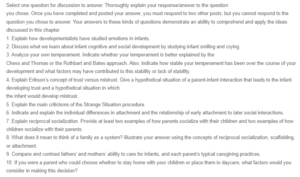Erikson Trust versus Mistrust Concept
Every parent wants their children to trust and be free to share everything with them. However, this trust is built from the early stages of a child’s development. Trust is a primary factor in a parent-child relationship because, in the early stages, children depend on their parents to see or ensure their needs are effectively met. Consistently, the trust versus mistrust concept is the first stage of Erickson’s theory of psychosocial development and happens between birth and 12 months of age (Berk, 2022). This is the most important stage in a child’s life since the infant is completely reliant on the parents and caregivers, and the development of trust is based on the quality and dependability of the baby’s parents or caregivers. In this stage, the infant either gets to view other people as trustworthy or develops a fundamental distrust of the environment, parents, or caregivers. Hire our assignment writing services in case your assignment is devastating you.
Erikson states that the first year of a child’s life is recognized by the trust versus mistrust stage of development (Gross, 2020). Notably, in this phase, infants do not understand nor know what is happening and rely entirely on the parents for their needs, such as feeding, changing diapers, and bathing. Therefore, for Erikson, trust is built up in a parent-child interaction when a child’s needs are consistently met, and mistrust is developed between a parent and a child when their needs are inconsistently met, delayed, or neglected (Berk, 2022). A perfect example of the trust concept between a parent and child is a child crying, and immediately, the parent quickly attends to the baby by checking on the diapers or breastfeeding the child until they stop crying. This builds trust between the parent and child because the child feels valued since his needs have been met consistently and timely. On the other hand, if every time a child cries, the parent ignores, neglects, or at times is not around to respond to the child’s cry, then such neglect may lead a child to develop mistrust because the parent is inconsistent in meeting the child’s needs.
References
Berk, L. E. (2022). Development through the lifespan. Sage Publications.
Gross, Y. (2020). Erikson’s stages of psychosocial development. The Wiley Encyclopedia of Personality and Individual Differences: Models and Theories, 179-184.
ORDER A PLAGIARISM-FREE PAPER HERE
We’ll write everything from scratch
Question 

Erikson Trust versus Mistrust Concept
Select one question for discussion to answer. Thoroughly explain your response/answer to the question you chose. Once you have completed and posted your answer, you must respond to two other posts, but you cannot respond to the question you chose to answer. Your answers to these kinds of questions demonstrate an ability to comprehend and apply the ideas discussed in this chapter.
1. Explain how developmentalists have studied emotions in infants.
2. Discuss what we learn about infant cognitive and social development by studying infant smiling and crying.
3. Analyze your own temperament. Indicate whether your temperament is better explained by the
Chess and Thomas or the Rothbart and Bates approach. Also, indicate how stable your temperament has been over the course of your development and what factors may have contributed to this stability or lack of stability.
4. Explain Erikson’s concept of trust versus mistrust. Give a hypothetical situation of a parent-infant interaction that leads to the infant developing trust and a hypothetical situation in which the infant would develop mistrust.
5. Explain the main criticisms of the Strange Situation procedure.
6. Indicate and explain the individual differences in attachment and the relationship of early attachment to later social interactions.
7. Explain reciprocal socialization. Provide at least two examples of how parents socialize with their children and two examples of how children socialize with their parents.
8. What does it mean to think of a family as a system? Illustrate your answer using the concepts of reciprocal socialization, scaffolding, or attachment.
9. Compare and contrast fathers’ and mothers’ ability to care for infants, and each parent’s typical caregiving practices.
10. If you were a parent who could choose whether to stay home with your children or place them in daycare, what factors would you consider in making this decision?